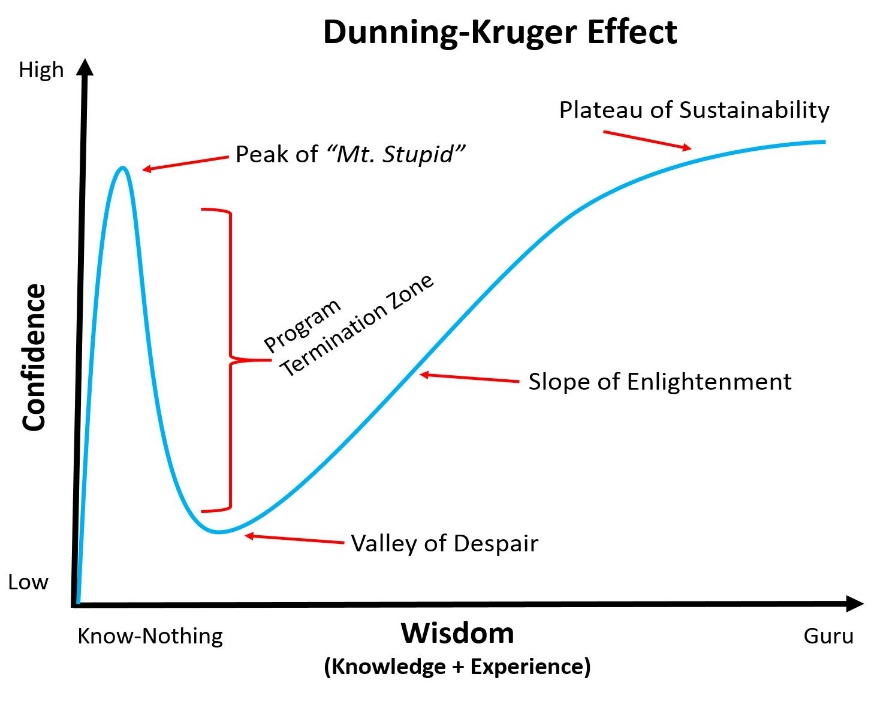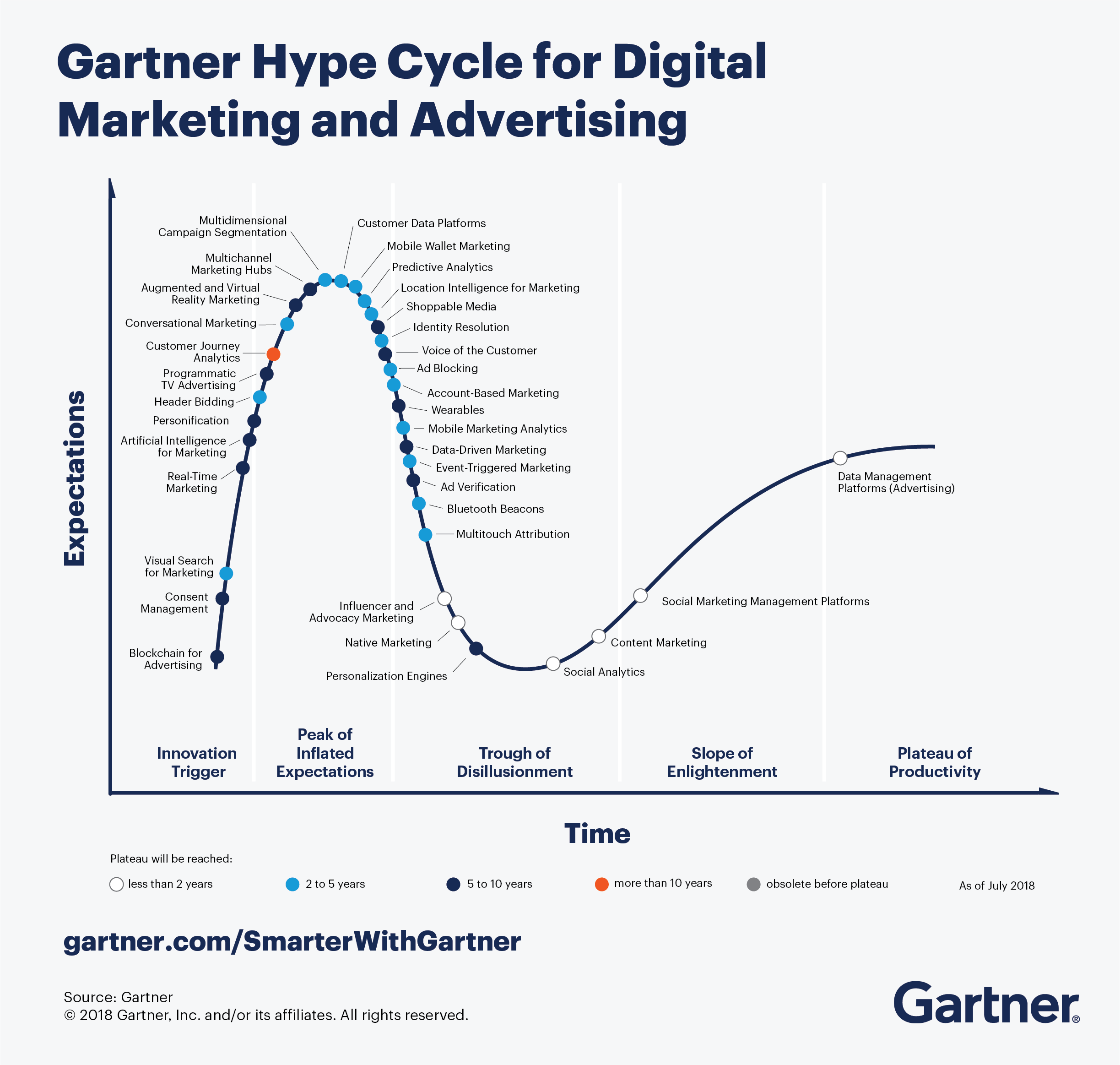How to See Beyond the Martech Hype from the Top of Mt. Stupid
By Neil Ruffolo, Director, Digital Strategy
There is nothing new under the sun. In my experience, most things touted as totally new are a natural evolution of what came before. And in the field of marketing technology – or martech – there is no shortage of examples. The Thomas Register may still live on as ThomasNet, but it’s hard to argue that traditional supplier directories were not bushwhacked by Alibaba and general purpose search engines like Google. SEO is likewise the technological descendent of naming your business AAA Precision Tool to gain the top spot in an alphabetical directory. Direct mail gave way to email, marketing automation and lead nurturing. And trade publications in every industrial niche are struggling to stay relevant as content marketing and programmatic advertising proliferate. I could go on, but you get the picture.
It came full circle for me when email service provider MailChimp introduced a printed postcard service. “Think of it as email for mailboxes,” is how they explain it. That just makes me laugh.
What’s not so funny is that each time this tech circle of life occurs, a parallel cycle begins that can divert resources and stunt business growth. The potential negative impact is compounded by the accelerating rate of martech change that has occurred over the last 20+ years. And there’s no sign it will slow down anytime soon.
In contrast, manufacturers tend to take a measured approach to the introduction of any new technology. This is understandable because an Operational Technology snafu has the potential to shut down an entire factory. When you consider all the ramifications of a heavy investment in martech, similar due diligence is warranted. Manufacturing executives who are cognizant of the lateral evolution of human proficiency alongside tech productivity can avoid the costly pitfalls of chasing the latest shiny object.
The Dunning-Kruger Effect: Stupid Is As Stupid Does
The fool doth think he is wise, but the wise man knows himself to be a fool
— William Shakespeare (1564 – 1616)
In the late 1990s, psychologists David Dunning and Justin Kruger observed how expertise and confidence are inversely related. In other words, profound ignorance tends to be accompanied by extreme overconfidence and a sense of absolute certainty. With increasing knowledge of a subject comes an awareness of the complexities and all there is yet to learn. So, as real expertise develops, one’s sense of certainty actually fluctuates. This is known as the Dunning-Kruger Effect.

At some point in our careers, we have all worked with that guy — that overconfident dolt who knows enough to be dangerous. In fairness, he’s got some valuable qualities too. He is enthusiastic and willing to take on new challenges. But let’s face it, no one wants to be that guy. And making strategy decisions like that guy is just as foolish, but people do it all the time. Fortunately, Gartner publishes a report to provide executives the high-level perspective needed to see beyond the hype and assess the outlook of trending martech.
The Marketing Technology Hype Cycle
The Gartner Hype Cycle is based on the same basic concept as the Dunning-Kruger Effect. But rather than charting the journey of a person from newbie to expert, it represents specific technologies through five stages of evolution from promise to productivity. Each stage is characterized by different opportunities and challenges. So whether or not to invest in a new technology and when depends on your business priorities and the competitive landscape. A key to success and positive outcomes is assessing the developmental stage of a technology and knowing what to expect as it matures.

1. Genesis: The Innovation Trigger
“In the beginning was the Word.”
The period following a technology breakthrough is when a buzzword takes root, like Blockchain, Chatbot, Artificial Intelligence, Machine Learning, Predictive Analytics, Marketing Automation, Lead Nurturing, Multi-Touch Attribution, Social Marketing Management, or Content Marketing. Longer names are often shortened to acronyms like DMP, CRM, CDP, DSP, or ABM. At this stage, media interest in “the next killer app” brings a lot of publicity, but commercial viability is unproven.
This is not necessarily a bad time to invest resources. In fact, early adoption has the potential to develop into a competitive advantage. Baileigh is an example of an industrial brand that embraced social media relatively early in its hype cycle. The resulting Baileigh Army of supporters that has added immeasurable value to the brand would be much more difficult (and costly) to replicate today. The drawback to early adoption is that it requires a lot of faith and time. The business relevance is not always clear at first. And payback does not come right away. The risk of waste and wrong turns is greater during this early phase, but so are the potential long-term rewards.
2. Mt. Stupid: The Peak of Inflated Expectations
“This is the best thing since… [fill-in-the-blank].”
This stage is the zenith of irrational exuberance when all the promises of future productivity come complete with unicorns and rainbows. The few real success stories have been well publicized. And FOMO makes it a tempting time to jump in. Pressure to do so could start coming from those above you, as well as those who have been clamoring from below.
Real knowledge is to know the extent of one’s ignorance
— Confucius (551 – 479 BC)
If any point in the hype cycle is a bad time to invest resources, this might be it. Even if the long-term outlook is positive, the immediate road ahead will be rough. The shiny object is about to lose much of its luster as reality sets in. So if your professional reputation can’t take a short-term hit, you might want to wait it out through the next stage.
3. Trough of Disillusionment
“This is never going to work.”
There comes a time of reckoning for every new technology and this stage is when that happens. Enthusiasm wanes as many early trials and pilot implementations fail to deliver on the initial promise. Faced with unanticipated challenges, many early adopters lose faith and cut their losses. The landscape of technology vendors also thins at this juncture as some fail and others consolidate.
In spite of everything, this could be a good time to start investing resources. If the long-term outlook is still good, there is nowhere to go but up. The biggest challenge will be convincing other stakeholders who have opinions tainted by a bad experience, or the growing amount of negative media.
4. Slope of Enlightenment
“Ok. It’s starting to make sense.”
The business purpose of a technology becomes a lot clearer to more people at this stage. Best practices, KPIs, and benchmarks are being established. And success stories are becoming more common. Apprehension subsides and more new initiatives are being funded.
There is less risk for the sponsoring executive at this stage, because measurable progress, or a quick win, is becoming more likely. Be mindful at this stage if you hear yourself or someone else say “Tried it. Didn’t work.” That is your cue to re-assess the developmental stage of the technology in question. By this time, second- and third-generation tech has been improved based on the hard lessons learned in earlier stages.
5. Plateau of Productivity
“We got this.”
This is the Promised Land. But in this final stage, there is very little fanfare. The technology’s relevance and applicability are met with little resistance because the payoff is clear and widely recognized. Real sustainability has been achieved.
By this time everyone is doing it. And by “everyone” I mean about 20 percent of enterprises are actually doing it. The other 80 percent know they should be. Allocating resources is now more a matter of politics and prioritization than strong skepticism.
The more you look at the technology hype cycle wave, the more it also resembles a traditional story arc from exposition through rising action and climax, followed by falling action and resolution. Unlike a two-hour movie, it can take up to 10 years for a hype cycle to play out. By then it may be time to start it all over again.
Ironically, the Gartner Hype Cycle has itself been hyped as “one of the more brilliant insights in the history of technology, … right up there with Moore’s Law.” But like every new technology it borrows from the past to benefit the future. Wise executives do that too.

